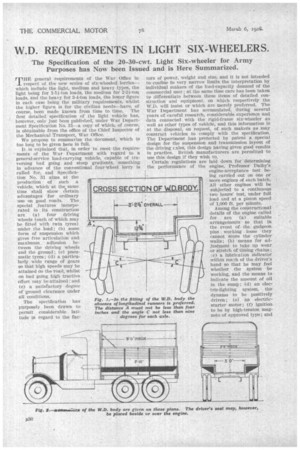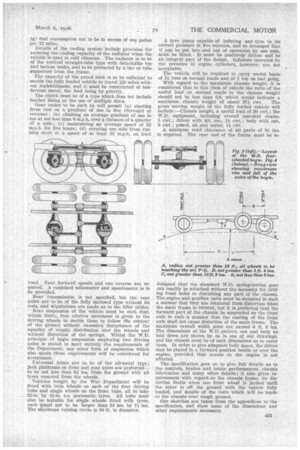W.D. REQUIREMENTS IN LIGHT SIX-WHEELERS.
Page 56

Page 57

If you've noticed an error in this article please click here to report it so we can fix it.
The Specification of the 20-30-cwt. Light Six-wheeler for Army Purposes has Now been Issued and is Here Summarized.
Timgeneral requirements of the War Office in respect of the new series of six-wheeled lorries-which include the light, medium and heavy types, the light being for 1-1i-ton loads, the medium for 2-2-ton loads, and the heavy for 3-4-ton loads, the lower figure in each case being the military requirements, whilst the higher figure is for the civilian needs—have, of course, been made known from time to time. The first detailed specification of the light vehicle has, however, only just been published, under War Department Specification No. 31—a copyof Which, of course, is obtainable from the office of the Chief Inspector of the Mechanical Transport, War Office.
We propose to summarize the 'document, which is too long to be given here in full.
The specification has purposely been drawn to permit considerable latitude M regard to the tic:. tors of power, weight and size, and it is not intended to, confine to very narrow limits the interpretation by individual makers of the load-capacity demand of the commercial user; at the same time care has been taken to differentiate between these items of detailed construction and equipment, on which respectively the W.D. will insist or which are merely preferred. The War Department has accumulated, during several years of careful research, considerable experience and data connected with the rigid-frame six-wheeler as well as other types of vehicle, and this information is at the disposal, on request, of such makers as may construct vehicles to comply with the specification. The Department has protected by patent a special design for the suspension and transmission layout of the driving axles, this design having given good results in practice. British manufacturers are permitted to use this design if they wish to.
Certain regulations are laid down for 'determining the performance of the engine, Professor Dalby's •
engine-acceptance test being carried out on one nr more engines of each batch. All -other engines will be subjected to a continuous two hours' test, under full load f aid at a piston speed of 1,000 ft. per minute.
Among the constructional details of the engine called for are (a)' suitable arrangernents so that in the event ofthe gudgeon pins working loose they cannot score the cylinder walls; (b) means for adjustment to take up wear or stretch of tithing chains; ;.c) -a lubrication indicator within reach of the driver's hand so that he may feel whether the system be working, and the means to indicate the amount of oil in the sump; (d) an electric-lighting system, the dynamo to be positively driven; (e) an electricstarter motor ; (f) ignition to be by high-tension magrieto of approved type; and
(g) fuel consumption not to be in excess of one gallon per 12 miles, Details of the cooling system include provision for reducing the cooling capacity of the radiator when the vehicle is used in cold climates. The radiator is to be of the vertical straight-tube type with detachable tap and bottom tanks, and to be protected by a bar or tube supported from the frame.
The capacity of the petrol tank is to be sufficient to enable the fully loaded vehicle to travel 120 miles without replenishment, and it must be constructed of nonferrous metal, the feed being by gravity.
The clutch must be of a type which does not include leather lining or the use of multiple discs.
Gear ratios to be such as will permit (a) starting from rest on a gradient of one in five (forward or reverse) ; (b) climbing an average gradient of one in ten at not less than 8 ro.p.h_ over a distance of a quarter of a mile; (c) maintaining an average speed of 22 m.p.h. for five hours; (d) covering one mile from running start at a speed of at least 33 m.p.h. on level road. Four forward speeds and one reverse are required. A combined mileometer and speedometer is to be provided.
Rear transmission is not specified, but the rear axles are to be of the fully enclosed type without tie rods, and stipulations are made as to the filler orifice.
Rear suspension of the vehicle must be such that, within limits, free relative movement is given to the driving wheels to enable them to follow the contour of the ground without excessive disturbance of the equality of weight distribution over the wheels and without distortion of the springs. Whilst the W.D. principle of bogie suspension employing two driving axles is stated to meet entirely the requirements of the Department, any other form of suspension which also meets those requirements will be considered for acceptance.
Universal joints are to be of the all-metal type; sack platforms on front and rear axles are preferred— to be not less than 91 ins, from the ground with all tyres removed from the wheels.
Vehicles bought by the War Department will be fitted with twin Wheels on each of the four driving hubs and single wheels on the front hubs, all, to take 32-in. by 4i-in. s.s. pneumatic tyres. All hubs must also be suitable for single wheels fitted with tyres, each wheel not to be larger than 34 ins. by 71 ins. The daximum turning circle is 50 ft. in diameter. A tyre pump capable of inflating any tyre to its correct pressure in five minutes, and so arranged that it can be put into and out of operation by one man, must be fitted. It must be positively driven and be an integral part of the design. Inflators operated by the pressure in engine cylinders, „however,' are not acceptable.
The vehicle will be required to carry useful loads of 11 tons on normal roads and of 1 ton on bad going.
With regard to the maximum chassis weight, it is considered that in this class of vehicle the ratio of the useful load on normal roads to the chassis weight should not be less than 0.8, which would indicate a maximum chassis weight of about 371 cwt. The gross movingweight •of the fully loaded vehicle will include :—Chassis weight, a useful load of 30 cwt.; the W.D. equipment, including overall non-skid chains, 5 cwt.; driver with kit, etc., 14 cwt.; body with cab, 9 ewt.; petrol, oil and water, 11 cwt.
A minimum road clearance of all parts of 91 ins. Is required. The rear end of the frame must be so designed that the standard W.D. spring-towing gear can readily be attached without the necessity for drilling fresh holes or disturbing any part of the chassis. The engine and gearbox units must be mounted in such a manner that they are insulated from distortion when the main frame is twisted, but it is preferred that the forward part of the chassis be suspended on the front axle in such a manner that the canting of the front axle shall not cause distortion of the main frame. The maximum overall width must not exceed 6 ft. 6 ins. The dimensions of the W.D.-pattern cab and body as laid down are shown by us in one of our drawings, and the chassis must be of such dimensions as to carry them. In order to give adequate body space, the driver may be placed in a forward position beside or over the engine, provided that access to the engine is not affected.
The specifitation goes on to give full details as to the controls, brakes and brake performances, chassis lubrication and many other details; it also gives requirements with regard .to the chassis frame, its distortion limits when one front wheel is jacked until the other is off the ground with the vehicle fully loaded, and details of the tests which will be made to the chassis over rough ground.
Our sketches are taken from the appendices to the specification, and show some of the dimensions and other requirements necessary.




















































































































